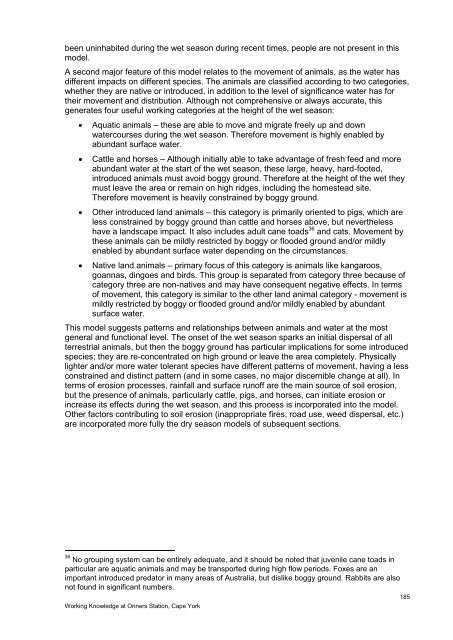WfHC - cover page (not to be used with pre-printed report ... - CSIRO
WfHC - cover page (not to be used with pre-printed report ... - CSIRO
WfHC - cover page (not to be used with pre-printed report ... - CSIRO
You also want an ePaper? Increase the reach of your titles
YUMPU automatically turns print PDFs into web optimized ePapers that Google loves.
een uninhabited during the wet season during recent times, people are <strong>not</strong> <strong>pre</strong>sent in this<br />
model.<br />
A second major feature of this model relates <strong>to</strong> the movement of animals, as the water has<br />
different impacts on different species. The animals are classified according <strong>to</strong> two categories,<br />
whether they are native or introduced, in addition <strong>to</strong> the level of significance water has for<br />
their movement and distribution. Although <strong>not</strong> com<strong>pre</strong>hensive or always accurate, this<br />
generates four useful working categories at the height of the wet season:<br />
Aquatic animals – these are able <strong>to</strong> move and migrate freely up and down<br />
watercourses during the wet season. Therefore movement is highly enabled by<br />
abundant surface water.<br />
Cattle and horses – Although initially able <strong>to</strong> take advantage of fresh feed and more<br />
abundant water at the start of the wet season, these large, heavy, hard-footed,<br />
introduced animals must avoid boggy ground. Therefore at the height of the wet they<br />
must leave the area or remain on high ridges, including the homestead site.<br />
Therefore movement is heavily constrained by boggy ground.<br />
Other introduced land animals – this category is primarily oriented <strong>to</strong> pigs, which are<br />
less constrained by boggy ground than cattle and horses above, but nevertheless<br />
have a landscape impact. It also includes adult cane <strong>to</strong>ads 36 and cats. Movement by<br />
these animals can <strong>be</strong> mildly restricted by boggy or flooded ground and/or mildly<br />
enabled by abundant surface water depending on the circumstances.<br />
Native land animals – primary focus of this category is animals like kangaroos,<br />
goannas, dingoes and birds. This group is separated from category three <strong>be</strong>cause of<br />
category three are non-natives and may have consequent negative effects. In terms<br />
of movement, this category is similar <strong>to</strong> the other land animal category - movement is<br />
mildly restricted by boggy or flooded ground and/or mildly enabled by abundant<br />
surface water.<br />
This model suggests patterns and relationships <strong>be</strong>tween animals and water at the most<br />
general and functional level. The onset of the wet season sparks an initial dispersal of all<br />
terrestrial animals, but then the boggy ground has particular implications for some introduced<br />
species; they are re-concentrated on high ground or leave the area completely. Physically<br />
lighter and/or more water <strong>to</strong>lerant species have different patterns of movement, having a less<br />
constrained and distinct pattern (and in some cases, no major discernible change at all). In<br />
terms of erosion processes, rainfall and surface runoff are the main source of soil erosion,<br />
but the <strong>pre</strong>sence of animals, particularly cattle, pigs, and horses, can initiate erosion or<br />
increase its effects during the wet season, and this process is incorporated in<strong>to</strong> the model.<br />
Other fac<strong>to</strong>rs contributing <strong>to</strong> soil erosion (inappropriate fires, road use, weed dispersal, etc.)<br />
are incorporated more fully the dry season models of subsequent sections.<br />
36 No grouping system can <strong>be</strong> entirely adequate, and it should <strong>be</strong> <strong>not</strong>ed that juvenile cane <strong>to</strong>ads in<br />
particular are aquatic animals and may <strong>be</strong> transported during high flow periods. Foxes are an<br />
important introduced <strong>pre</strong>da<strong>to</strong>r in many areas of Australia, but dislike boggy ground. Rabbits are also<br />
<strong>not</strong> found in significant num<strong>be</strong>rs.<br />
Working Knowledge at Oriners Station, Cape York<br />
185
















